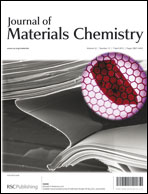Luminescence and energy transfer of a color tunable phosphor: Dy3+-, Tm3+-, and Eu3+-coactivated KSr4(BO3)3 for warm white UV LEDs†
Abstract
A series of Dy3+-, Tm3+-, Eu3+-coactivated KSr4(BO3)3 phosphors were synthesized via a standard solid-state reaction under normal ambient air, and the emission colors could be tuned from blue to yellow and then to red, including almost all the white light region, through tuning the energy transfer. It was discovered that the energy is transferred from Tm3+ to Dy3+ by: directly observing overlap of the excitation spectrum of Dy3+ and the emission spectrum of Tm3+; the systematic relative decline and growth of emission bands of Tm3+ and Dy3+, respectively; and faster decay times of the blue emissions from energy donors. The resonance-type energy transfer from Tm3+ to Dy3+ was demonstrated to be via the dipole–quadrupole mechanism and the critical distance of energy transfer was calculated to be 20.7 Å. Rietveld refinements of the crystal structures of the products obtained from


 Please wait while we load your content...
Please wait while we load your content...